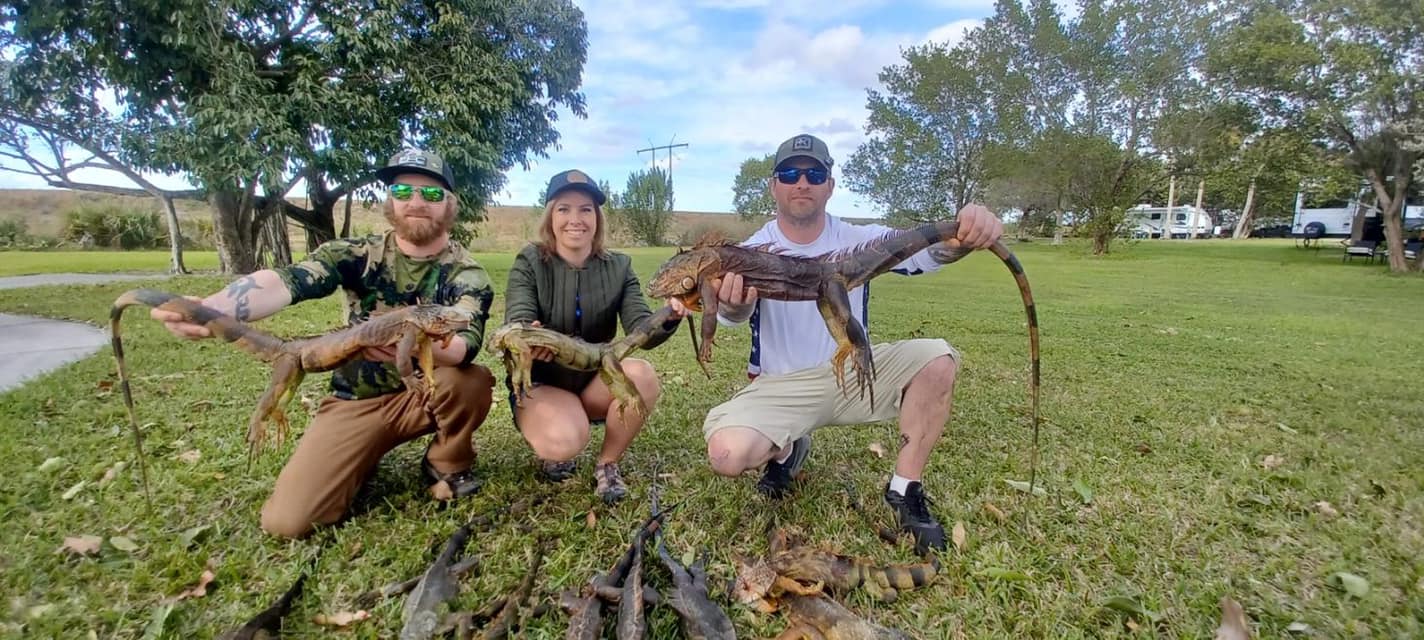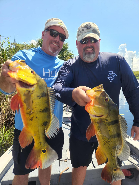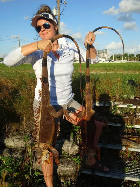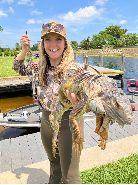THE NEWEST HUNTING ADVENTURE
" IT"S A BAD DAY TO BE AN IGUANA"
Catering to small groups and more adventurous folks, we're known for taking the less traveled paths and going a little further into the wilderness. It's what sets our tours apart from the more mainstream tourist Exotic companies. It also fits well with our philosophy of incorporating conservation and educational initiatives with invasive species programs, such as the Green Iguanas. It is a plessure to anounce that I am the first person ( Gene Parker) of the US mainland, to bring and promote Guided Air Riffle " Hunts to Puerto Rico and Florida, using only High Powered Pellet Rifels in .22 cal and 25 cal. This style of hunting is the new craze!! No limits-No Seasons-Hunt anytime
- Hunting Guide Gene Parker
Iguanas: How Florida’s Feisty Lizard Problem Can Be Your Next Big Hunting Experience
When you think of a large, green, amphibious reptile roaming Floridian neighborhoods, you may have a particular image in mind. In the last few decades, you may not be surprised to hear that this creature is leaving chaos in its wake, to the point where current land management is at its wits end.
What you may be surprised to hear is that this creature in question is not southern Florida’s unfriendly neighborhood crocodile.
It’s the green iguana.
And the hunting season in Florida is emphatically--and indefinitely--open.
Wait--Florida Has Iguanas?
We may not think of the iguana as a traditional target for an afternoon hunt, but in Florida, they have forced themselves more and more into the spotlight. The green iguana (with the quite amusing and surprisingly memorable scientific name of iguana iguana) is not a native species in Florida, but in the last few decades, they have established breeding populations, especially in the warmer areas of southern Florida.
These feisty little critters look like they belong in a jungle, but they are often found in Floridian suburbs, often making their homes in agricultural areas and urban developments alike. In the wild, they are born underground, and they are initially quite a social bunch, with the young iguanas sleeping in piles side-by-side, often with alligators a stone’s throw nearby. Green iguanas are quite hardy, comfortable both in the water (whether swimming in fresh or saltwater) as well as being quite talented climbers.
They are also incredibly popular pets due to their striking features--they can grow up to five feet long, weigh up to 17 pounds, and despite their name, can actually be a wide array of colors--green, red, blue, black, and everything in between!
These handsome fellas are well loved in the exotic pet trade, and while they live up to 10 years in the wild, their lifespan nearly doubles that in captivity. In 1995, over 1 million iguanas were imported to the United States (CIte). However, they grow quickly, and some ambitious owners may not have the resources to care for such a large reptile. It is suspected that many of the current population are descended from individuals that were released, either accidentally or on purpose.
Since When Does Florida Have Wild Iguanas?
Unlike their alligator cousins, iguanas have not always been associated with Florida. They were first reported around 1960 in Miami-Dade County along the southeastern coast. They do occasionally show up farther north, often suspected to be escaped or released pets. However, due to their cold-blooded nature, these populations are generally not long-lasted. While they are hardy climbers--and some are even quite good at falling, able to withstand 50 foot drops without a scratch--even these talents have their limits. These iguanas grow immobile when the temperatures fall below 44 degrees fahrenheit, which can lead to literal showers of petrified iguanas falling from the trees.
This led to the green iguana populations putting down deeper roots along southern Florida. Their affinity for the water and their hardy nature make it unsurprising that they’ve made an appearance outside of their natural habitat. In southern Florida, many are suspected to have arrived on the peninsula by hitching rides on crossing boats and shipping crates.These critters often make their homes in culverts and drainage pipes, which makes the urban canals of South Florida a perfect place for them to claim.
It’s unknown how many iguanas are roaming Florida now. More than 7,000 iguana sightings have been reported, most of those documented since 2012.
Why Hunt Iguanas?
What damage can these cute little living dinosaurs do? As it turns out, quite a lot.
As is the case with most destructive invasive species, the green iguana has no natural predators in southern Florida. This means that the population can continue to grow without any other animals helping to keep them in check. This might not be so bad if the natural landscape limited their populations, but as it turns out, these creatures are both hungry and destructive.
Hungry: These little lizards have a big appetite! They are normally herbivores with a hankering for flowers, fruits, and vegetables-with a few exceptions such as insects and other small critters--but they still pose a significant threat to the natural wildlife. They eat more than the neighborhood’s petunias: they have also been found to eat threatened species directly (including tree snails), as well as competing with the endangered Miami Blue butterfly by eating butterfly’s vegetation, the nickerbean plant.
Destructive: Lizards don’t need to be Godzilla-sized to cause Godzilla-sized havoc. Green iguanas love to dig burrows to live in, and when the labyrinth of burrows happens to be under current infrastructure, disaster ensues. These burrows can ultimately weaken and crumble sidewalks, seawalls, foundations, and canal banks alike. Think this just leads to an occasional pothole? Think again! Tunnels left by iguanas in a West Palm Beach dam caused $1.8 million in damages, and in 2018, an unlucky iguana wreaked havoc in a Key West electrical facility and caused a ten minute power outage from its unpleasant adventuring.
More Than a Trophy Hunt--How To Hunt Iguanas in Southern Florida
Without natural predators, it’s up to humans to deal with this invasive species as firmly and fervently as possible. In 2019, The Florida Fish and Wildlife Conservation Commission (FWC) encouraged homeowners to exterminate green iguanas as humanly as possible whenever the reptiles are found on their property. No permits required, even on public lands! While the free-for-all has been tempered, there are now options to help cull the numbers of this invasive species in a safe and controlled manner and meet the goals of land management.
These days, there’s a new way to tackle the iguana problem: guided iguana hunting tours. These types of hunts are good for beginning outdoorsmen who are looking to get started, but they can also be a good fit for experienced hunters looking for a new type of adventure while also helping preserve the Floridian ecosystem from invasive species. As any seasoned hunter knows, hunting is not only a form of recreation--it can be a form of stewardship.
What does an iguana hunt look like? As it turns out, there are many different methods. Because iguanas are comfortable on both land and water, hunters can find them sprawled in the sun or out in the muck. Iguana season is open all year, and often, no permits are required on public lands. Bag limits aren’t usually applicable either. If you can find them, you can hunt them! That can be in a boat or in a field, close up with blowguns or far away to snipe them.
One of the most common methods of landing an iguana is by using airguns or air pellet rifles. This is a versatile and relatively easy way for hunters, no matter what amount of experience they have. However, other more creative means--such as blowguns, crossbows, fishing bow and arrows, and even a pole noose have been used.
If you want to try this experience for yourself, a guided hunt is never a bad way to go. The guides will know the best places to find these creatures, and even better, they may know what areas may need the populations culled more than others. From there, they can tailor your experience to your whims. Want to get out in the swamp? Your iguana hunt is only a boat ride away. Want to stay out dry in the sun? There are fields where iguanas sun themselves.
There is another benefit to consulting with a guide. These experts may even have some tasty iguana meat recipes up their sleeves, for the adventurous hunter who has equally ambitious taste buds. Don’t worry, the dishes are safe. Iguana is a traditional dish in parts of the Caribbean, and this tradition lives on strong in southern Florida.
Ready to get started? Consult a local guide today, and see what you can do to help Florida’s natural wildlife while also making the memory of a lifetime!
Resources used:
FWC- GREEN IGUANA
GREEN IGUANA - HOW STUFF WORKS
Not a native species and now has breeding populations in Florida
No natural predators
Introduced through pet trade
Good for beginning hunters looking to get started or experienced hunters looking for a new type of adventure while also helping preserve the Floridian ecosystem from invasive species
Homeowners initially encouraged to exterminate on sight--nuisance and dangerous to exist wildlife if they run rampant
While the free-for-all has been tempered, there are now options to help cull the numbers of this invasive species in a safe and controlled manner and met the goals of land management
First reported in 1960; in along Miami-Dade County’s southeastern coast
“In cleared habitats such as canal banks and vacant lots, green iguanas reside in burrows, culverts, drainage pipes and rock or debris piles. South Florida’s extensive man-made canals serve as ideal dispersal corridors to further allow iguanas to colonize new areas”
Appearance in northern areas occasional (often escaped or released pets), but not long-lasting, as these creatures do not handle colder temperatures well
Can grow up to five feet long and 17 pounds, and can be green, black, or an array of colors in between
Can swim in fresh and saltwater
Can live up to 10 years in the wild, nearly double that in captivity
Look like they belong in a jungle, but are often found in Floridian suburbs, often making homes in agricultural areas or urban developments.
What damage can these cute little living dinosaurs do? As it turns out, quite a lot.
Devour vegetation (including flowers, fruits, and vegetables), dig burrows that can weaken and ultimately crumble sidewalks, seawalls, foundations, and canal banks
Normally herbivores, but also have been found to eat threatened natural species, including tree snails and nickerbean (a plant which supports the endangered Miami Blue butterfly).
Droppings everywhere that can pass salmonella via contact to humans
HOW STUFF WORKS - GREEN IGUANA
Specifically talking about green iguana (with the quite amusing and surprisingly memorable scientific name of iguana iguana)
Property damage and wreaking havoc on native vegetation, to homeowners and business owners’ chagrin
Well-loved in the exotic pet trade
Talented climbers, and some are even hardy fallers (known to withstand 50-foot (15.2-meter) falls without a scratch
Born underground, and initially quite a social bunch, with the young iguanas sleeping in piles side-by-side, often with crocodiles a stone’s throw nearby
Their affinity for the water and their hardy nature make it unsurprising that they’ve made an appearance outside of their natural habitat. In southern Florida, many are suspected to have arrived on the peninsula by hitching rides on crossing boats and shipping crates.
They are also incredibly popular pets due to their striking features. In 1995, over 1 million iguanas were imported to the United States (CIte). However, they grow quickly, and some ambitious owners may not have the resources to care for such a large reptile. It is suspected that many of the current population are descended from individuals that were released, either accidentally or on purpose.
It’s unknown how many iguanas are roaming florida now. More than 7000 iguana sightings have been reported, most of those documented since 2012.
More than plants are at stake. In 2018, an unlucky iguana wreaked havoc in a Key West electrical facility and caused a ten minute power outage from its unpleasant adventuring. Those costs add up--tunnels left by iguanas in a West Palm Beach dam caused $1.8 million in damages.
In 2019, the Florida Fish and Wildlife Conservation Commission (FWC) made headlines by encouraging homeowners "to [humanely] kill green iguanas on their property whenever possible." (And in case you're wondering, one doesn't need a license or permit to hunt them on public lands.)
Several worried citizens have also called for Floridians to eat more iguana meat — which, after all, is a traditional entree in parts of the Caribbean.
This rash of cold weather was nippy enough to immobilize the region's iguanas, as the animals go into paralysis when the thermometer hits 44 degrees Fahrenheit (6.6 degrees Celsius) or so. That was cold enough to immobilize the region's iguanas, as the animals go into paralysis when the thermometer hits 44 degrees Fahrenheit (6.6 degrees Celsius) or so. Twitter blew up with pictures of motionless iguanas scattered across the Floridian landscape — and plummeting from trees like scaly coconuts.
Hunting them encouraged due to their impact on local wildlife
How to Hunt Green Iguanas: Guided Air Riffle Hunts
Can be by land or water
Year-round hunting availability
Often no permits required
Can be up-close hunting or from a distance (sniping hunts)
You can eat them--recipes from Central America
Pros of hunting with a licensed outfitter "Hunting Iguanas Florida"
We are licensed and insured and registered with the State of Florida
Set high standards as in any hunting service with credability
Active website
We specialise in Iguanas.
We do not get involved with 'Social Media Drama'
All of our hunting rigs are top notch tournament boats for your comfort














